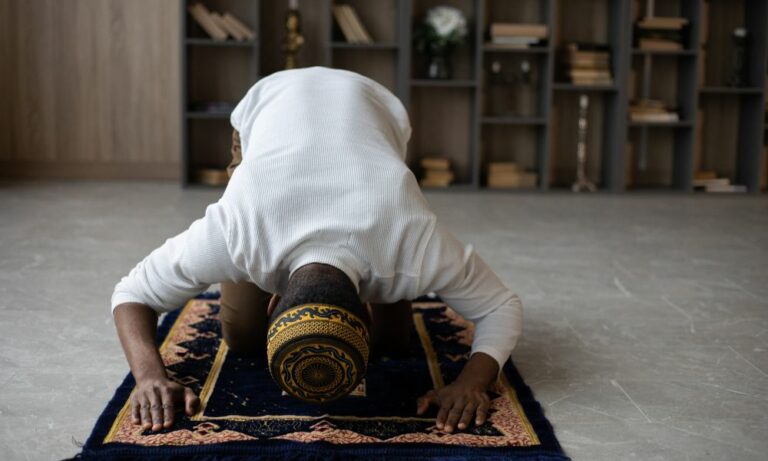How to perform Isha Prayer: Discover the Ultimate Guide to Perfecting Your Isha Prayer!
Understanding how to perform the Isha Prayer can be difficult, particularly for new converts. Isha, one of the five daily prayers required by Islam, is filled with significant rituals and recitations that require precision.
This blog will take you through each step of correctly and reverently performing this prayer, making it easier.
Are you ready to become an excellent worshipper? Let’s get started!
Understanding Isha Prayer


Salat al Isha, the last of Islam’s five daily prayers, is unique among all other Salah Times. According to Islamic tradition, it is performed after the twilight has passed. It is governed by several rules to ensure proper execution.
Niyyah, or intention, marks the start of this prayer, which requires your heartfelt commitment to pray Isha for the sake of Allah SWT.
This prayer is divided into three sections: four rak’aats Fard, two rak’aats Sunnah, and three rak’aats Witr. Al-Fatiha Surah is recited in every rak’aat.
Interestingly, there are some gender differences; females should recite in a soft voice, whereas males must recite aloud during Fajr, Maghrib, and the Isha prayers.
Understanding each step enhances our Salat experience and brings us closer to effectively fulfilling our religious obligations.
Steps to Perform Isha Prayer


To perform the Isha Prayer, start by performing the four Rak’aats Fard part, and then complete the two Rak’aats Sunnah part.
Executing the Four Rak’aats Fard Part
This essential part of Salat al Isha is vital in completing your daily prayers.
Intention and Dua of Istiftah:
The step is initiated by making a new Niyyah (Intention) for offering the Fard of Isha prayer. Following this declaration of intention, you recite “Takbir” and then begin uttering “‘SubhanakAllahumma, wa bihamdika tabarakasmuka wa ta’ala jadduka wa la ilaha ghairuk.” Sunan an-Nasa’i 900
Surah Fatiha


Then comes the recitation of Surah Al-Fatiha and another Quranic Surah, such as Surah An-Nas, or any other chapter from the Holy Quran other than Al-Fatiha. Book 2, Hadith 172, Sahih Muslim 396c
Remember to recite these parts quietly if you’re a female, while males recite them aloud during this late-night prayer session.
Bowing (Ruku) and Qawmah (Rising from bowing)


When going into ruku, say “Allahu Akbar”, then recite “Subhana Rabbi Al Adheem” 1 at least thrice. Now rise from ruku while saying “Sami Allahu Liman Hamidah” 2, then say “Rabbana Walakal Hamd.” 3
Prostration (Sajda)


Go into the prostration by saying “Allahu Akbar,” and during the prostration, recite “Subhana Rabbi Al A’la” 4 at least thrice. Rise from this position and sit. Each time you go into prostration and rise from it, you will say “Allahu Akbar.”
Jalsa (sitting between two prostrations)


After performing one sajda, sit and relax. This gap between the first and second prostration is known as Jalsah. You may recite “Rabbighfirli” 5 During it. Now perform the second prostration, and after that, stand up for the second Rakah.
Reciting Tashahud in Second Rakah


In the second Rakah, after the second prostration, don’t stand up. Instead, recite Tashahud and then stand up. The Third Rakah is the same as the first.
Concluding the Prayer
The Fourth Rakah also resembles the second, but After Tashahud 6, you recite Durood-e-Ibrahimi 7 and the Dua “Allahumma Rabbana atina fid dunya hasanah wa fil akhirati hasanah wa qina ‘adhaban nar” 8 and then you end the prayer by saying Tasleem (Salutation to end the prayer).
References:
- Riyad as-Salihin 1175,
- Sunan an-Nasa’i 1072,
- Sunan Ibn Majah 877
- Sunan an-Nasa’i 1046
- Sunan Ibn Majah 897
- Sahih al-Bukhari 831,
- Sahih al-Bukhari 3370 ,
- Sahih al-Bukhari 4522.
Carefully maintain focus and proper pronunciation throughout, without rushing through your prayer.
Completing the Two Rak’aats Final Sunnah Part


Following the completion of the four rak’aat Fard portion of the Isha prayer, there are two additional rak’aats known as Sunnah Muakkadah. These rak’aats are significant because they are a voluntary act of worship as well as an opportunity to earn additional rewards from Allah SWT.
During these two rak’aats, it is recommended to recite any chapter from the Holy Quran after Surah Al-Fatiha.
The difference between these two rakaats and the Fard one is in the intention. You end the prayer with taslim instead of standing up in the second Rakah after Tashahud.
These two Sunnah are among the twelve Sunnah mentioned in a hadith by Prophet Muhammad PBUH.
مَنْ ثَابَرَ عَلَى ثِنْتَىْ عَشْرَةَ رَكْعَةً مِنَ السُّنَّةِ بَنَى اللَّهُ لَهُ بَيْتًا فِي الْجَنَّةِ أَرْبَعِ رَكَعَاتٍ قَبْلَ الظُّهْرِ وَرَكْعَتَيْنِ بَعْدَهَا وَرَكْعَتَيْنِ بَعْدَ الْمَغْرِبِ وَرَكْعَتَيْنِ بَعْدَ الْعِشَاءِ وَرَكْعَتَيْنِ قَبْلَ الْفَجْرِ ”
“Whoever is regular with twelve Rak’ah of Sunnah (prayer), Allah will build a house for him in Paradise: Four Rak’ah before Zuhr, two Rak’ah after it, two Rak’ah after Maghrib, two Rak’ah after Isha, and two Rak’ah before Fajr.”
Performing the Witr
It is the sunnah of the Prophet Muhammad PBUH to pray Witr alongside Tahajjud prayer (the one-third of night prayer). He advised Muslims to pray Witr alongside Isha if they are worried about not being able to wake up at night.
مَنْ خَافَ أَنْ لاَ يَقُومَ مِنْ آخِرِ اللَّيْلِ فَلْيُوتِرْ أَوَّلَهُ
If anyone is afraid that he may not get up in the latter part of the night, he should observe Witr in the first part of it;
In a hadith, Prophet Muhammad PBUH also told us about its number of Rak’aats:
الْوِتْرُ حَقٌّ. فَمَنْ شَاءَ فَلْيُوتِرْ بِخَمْسٍ. وَمَنْ شَاءَ فَلْيُوتِرْ بِثَلاَثٍ. وَمَنْ شَاءَ فَلْيُوتِرْ بِوَاحِدَةٍ ”
“Witr is Haqq.* Whoever wishes let him pray Witr with five (Rak’ah), and whoever wishes let him pray Witr with three (Rak’ah), and whoever wishes let him pray Witr with one (Rak’ah).”
We also understand from some ahadith in which the prophet Muhammad PBUH prayed seven or nine rak’aats of Witr. Sahih Muslim 737a, Sunan an-Nasa’i 1714. Sunan Ibn Majah 1191
Most Muslims prefer three rak’aats of Witr prayer, similar to three Fard rak’aats of Maghrib but differs slightly. In the third Rakah of the Witr prayer, after we say “sami’a Allahu leman hamedah”, we perform Dua-e-Qunoot.
“ اللَّهُمَّ اهْدِنِي فِيمَنْ هَدَيْتَ وَعَافِنِي فِيمَنْ عَافَيْتَ وَتَوَلَّنِي فِيمَنْ تَوَلَّيْتَ وَبَارِكْ لِي فِيمَا أَعْطَيْتَ وَقِنِي شَرَّ مَا قَضَيْتَ إِنَّكَ تَقْضِي وَلاَ يُقْضَى عَلَيْكَ وَإِنَّهُ لاَ يَذِلُّ مَنْ وَالَيْتَ وَلاَ يَعِزُّ مَنْ عَادَيْتَ تَبَارَكْتَ رَبَّنَا وَتَعَالَيْتَ ”
“O Allah, guide me among those Thou hast guided, grant me security among those Thou hast granted security, take me into Thy charge among those Thou hast taken into Thy charge, bless me in what Thou hast given, guard me from the evil of what Thou hast decreed, for Thou dost decree, and nothing is decreed for Thee. He whom Thou befriendest is not humbled. Blessed and Exalted art Thou, our Lord.”
Tips for Concentration During Isha Prayer
Maintaining focus and concentration during the Isha Prayer can be challenging, especially after a long day. Here are some tips to help you stay focused and connected during this important prayer:
- Find a Quiet Place: Select a peaceful and quiet location where you can pray without distractions. This will contribute to creating a calm environment that will aid in concentration.
- Mentally Prepare: Before beginning your prayer, take a few moments to clear your mind and mentally prepare yourself for the act of worship. Remember the importance of the Isha Prayer and the opportunity to connect with Allah SWT.
- Slow down your pace: Take your time as you complete each part of the prayer. Avoid rushing through your movements and instead, concentrate on being present in every moment.
- Reflect on the Meaning: Try to reflect on the meanings of Surahs and prayer positions as you recite them. Understand spoken words’ meaning and importance in your relationship with Allah SWT.
Common Mistakes to Avoid During Isha Prayer
- Rushing through the prayer without properly performing each position.
- Failure to recite Surah Al-Fatiha during all rak’aats of the Isha Prayer.
- Not fully bending when performing ruku (the bowing position) or touching the forehead to the ground when performing sujood (prostration).
- Allowing thoughts to wander or becoming distracted during prayer breaks concentration.
Conclusion
Performing the Isha Prayer holds great importance. Following the outlined steps and remaining focused during the prayer can establish a deep connection with Allah SWT.
To truly benefit from this beautiful act of worship, ensure that you make sincere intentions and strive for concentration. May your Isha prayers bring you peace and blessings, and strengthen your bond with Allah SWT. Stay committed to this essential aspect of your faith, and may it bring you spiritual fulfillment and closeness to your Creator.
FAQs
What is Isha prayer, and when should it be performed?
Isha prayer, also known as night prayer, is one of Islam’s five daily prayers. It takes place after sunset and before midnight.
How many rak’aats (units) are there in Isha prayer?
In general, there are 9 rak’aats: Four rak’aat Fard, two rak’aat Sunnah, and three rak’aat Witr.
What recitations and movements are involved in Isha prayer?
Various recitations from the Quran are made in each rak’ah of Isha prayer, including Al-Fatihah (the opening chapter) and additional verses or chapters. These recitations are accompanied by specific movements such as standing, bowing (raku), prostration (sujood), and sitting.
Can women perform Isha prayer at home instead of attending a mosque?
Yes, women can pray at home if they prefer for reasons such as convenience or safety. However, Muslims are encouraged to attend congregational prayers at mosques whenever possible because it promotes community unity and spiritual connection with other worshippers.
Як виконувати молитву Іша: відкрийте для себе найкращий посібник з освоєння молитви Іша!
Зрозуміти, як виконувати вечірню молитву, може бути важко, особливо новонаверненим. Вечірня молитва, одна з п’яти щоденних молитов, яких вимагає іслам, наповнена важливими ритуалами та декламаціями, які вимагають точності. Цей блог проведе вас через кожен крок виконання цієї молитви правильно та з благоговінням, полегшуючи це. Чи готові ви стати суперпоклонником? Давайте розпочнемо!Розуміння вечірньої молитви


Етапи здійснення вечірньої молитви


Впровадження Чотири раката є виконанням обов'язкової молитви Розділ
Ця важлива частина вечірньої молитви необхідна для завершення ваших щоденних молитов.Намір і вступне прохання:
Крок починається зі встановлення нового наміру для обов’язкової молитви Іша. Після цього проголошення намірів ви читаєте «Такбір», а потім починаєте вимовляти «Слава Богу і хвала Тобі, благословенний і Всевишній дід твій, і немає бога, крім Тебе».< /span>" Сунан ан-Насаї 900Аль-Фатіха


Кланяючись і стоячи (встаючи з поклону)


прострація


Джалса (сидить між двома поклонами)


Читання ташаххуда у другому ракаті


Завершення молитви
Четвертий ракат також схожий на другий, але після ташаххуда 6, Прочитайте Авраамову молитву 7 Благання: «Боже, Господи наш, дай нам добра в цьому світі і добра в моїй потойбіччі, і захисти нас від кари пекельного вогню». 8 Потім молитва завершується привітанням.рецензент:
- Ріяд Аль-Салехін 1175,
- Сунан ан-Насаї 1072,
- Сунан ібн Маджа 877
- Сунан ан-Насаї 1046
- Сунан ібн Маджа 897
- Сахіх аль-Бухарі 831,
- Сахіх аль-Бухарі 3370 ,
- Сахіх аль-Бухарі 4522.
завершено Два раката віршів минулого року Розділ


Струнна продуктивність
З Сунни Пророка Мухаммеда, хай благословить його Бог і благословить його, молитися Вітр молитвою Тахаджуд (третя-третина нічної молитви). Він порадив мусульманам виконувати молитву Вітр разом з Іша, якщо вони стурбовані тим, що не можуть прокинутися вночі. Хто боїться, що він не встане в кінці ночі, нехай молиться Вітр на її початку. Хто боїться, що він не встане в кінці ночі, нехай молиться Вітр на початку ночі. Сахіх Муслім 755a Також у хадісі пророк Мухаммад, хай благословить його Аллах і вітає, сказав нам про кількість його ракатів: Рядок вірний. Хто хоче, нехай молиться п’ять. А хто бажає, нехай молиться Вітр трійкою. А хто бажає, нехай помолиться один вір». «Вітр є право, тому хто хоче, нехай молиться п’ятьма, а хто хоче, нехай молиться трьома, а хто хоче, нехай молиться трьома, а хто хоче, нехай молиться трьома, а хто хоче, нехай молиться трьома, а хто хоче, нехай молиться трьома, а хто хоче, нехай молиться трьома, а хто хоче, нехай молиться трьома.» Хто хоче, нехай молиться одним Вітр. Ми також розуміємо з деяких хадисів, що Пророк Мухаммад, благословить його Бог і благословить його, молився сім або дев’ять ракатів Вітр. Сахіх Муслім 737a,< a href="https://sunnah.com/nasai:1714"> Сунан ан-Насаї 1714. Сунан ібн Маджа 1191 Більшість мусульман віддають перевагу молитві Вітр з трьома ракатами, подібно до трьох ракатів, обов'язкових у Марокко, але з невеликою відмінністю. У третьому ракаті молитви Вітр, після того як ми говоримо: «Бог чує тих, хто славить Його», ми виконуємо благання Кунут. «О Боже, введи мене серед тих, кого Ти вивів, захисти мене від тих, кого Ти помилував, піклуйся про тих, про кого Ти піклувався, і благослови мене в тому, що Ти дав, і захисти мене від зла що Ти постановив: «Ніхто не буде принижений Тобою, і ніхто не буде піднесений, кому Ти ворогував».«О Боже, введи мене серед тих, кого Ти вивів, і зроби мене безпечним серед тих, кому Ти помилував, і познач мене серед тих, кого Ти призначив, і благослови мене». Захисти мене від того, що Ти дав, і захисти мене від зла того, що Ти постановив, бо Ти постановляєш, і нічого проти Тебе не постановлено. Період> Сунан Абі Дауд 1425Поради щодо зосередження під час вечірньої молитви
Зберігайте фокус Під час вечірньої молитви це може бути важко, особливо після довгого дня. Ось кілька порад, які допоможуть вам залишатися зосередженими та підтримувати зв’язок під час цієї важливої молитви:- Знайдіть тихе місце: Виберіть тихе і спокійне місце, де ви можете молитися, не відволікаючись. Це сприятиме створенню спокійної обстановки, яка допоможе зосередитися.
- Психічна підготовленість: Перш ніж почати молитву, виділіть кілька хвилин, щоб очистити свій розум і подумки підготуватися до поклоніння. Пам’ятайте про важливість вечірньої молитви та можливість спілкування з Богом Всевишнім.
- Уповільніть крок: Не поспішайте, завершуючи кожну частину молитви. Уникайте поспішних рухів і натомість зосередьтеся на присутності кожного моменту.
- Розглянемо значення: Спробуйте подумати про значення сур і позиції молитви, читаючи їх. Зрозумійте значення сказаних слів і їхню важливість у ваших стосунках із Всемогутнім Богом.
Поширені помилки, яких слід уникати під час вечірньої молитви
- Поспішаючи в молитву, не виконуючи кожну позицію правильно.
- Непрочитання сури Аль-Фатіха в усіх ракатах молитви Іша.
- Не згинатися повністю під час поклону або торкатися чолом до землі під час поклону.
- Дозвольте думкам блукати або відволікатися, зосереджуючись на молитовній перерві.







